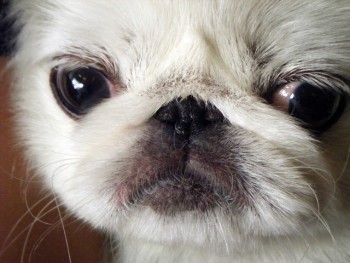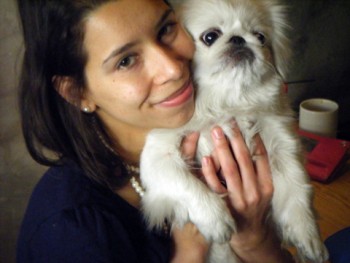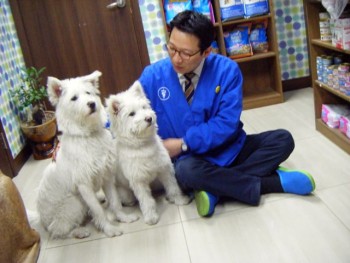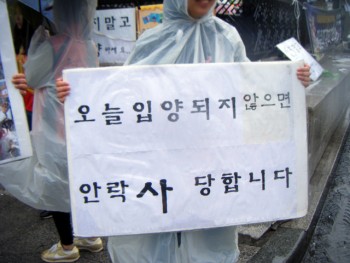“Here are best friends under mercy killing, TODAY!”
“If not adopted, they are killed.”
The signs are in English and Korean. A team of Korean volunteers wear bright orange vests—one cuddles a silver schnauzer in her arms and another has a white curly-haired dog in a sling. Medium-sized dogs stand on leashes near a stack of wire cages, with one person holding three leashes. It’s a sunny Saturday in April. Seoul’s Itaewon area is known for its large foreign population, and many passers-by stop to look at the animals on this busy street corner across from the Hamilton Hotel. Almost all the animals up for adoption today are dogs, but the top cage holds a big black and white cat. The signs are misleading because the volunteers will not be taking any animals to their deaths. Instead they will go back to “pet hotels” (that is, private animal hospitals) if they’re not adopted. Adoptions allow the group to rescue more animals, who might otherwise be killed.
“It’s not lying,” spokeswoman Nuri Wang says. “It sends a shocking message to the people.”
Government homeless animal statistics for 2010
Number of homeless animals (nationwide)
100,899
(57,893 dogs, 42,093 cats,
913 other)Number of lost animals reunited with families
6,884Number of animals adopted
25,096Number of animals transferred or donated to individuals or organizations
3,220Number of natural deaths
19,066Number of animals killed
26,996Number of animals released (as part of TNR programs)
15,376Other (includes animals still in shelters and animals who haven’t been caught yet)
4,261Source: Animal Protection
Management System
The group is called Yuhaengsa, a Korean abbreviation for “people seeking happiness for abandoned animals.” Many of the dogs in the group’s care are unclaimed strays. Sometimes, Wang says, the volunteers pay to rescue abused or neglected dogs from bad homes. It’s only her fifth week as a volunteer so she doesn’t know every animal’s individual rescue story. But she says two of the leashed dogs have been abandoned at least three times—most recently by foreigners who left them behind after they moved. Yuhaengsa’s screening process is “not perfect,” Wang says, “but we do our best.” The volunteers check the adopter’s ID card and take the animal and the adopter to the vet clinic together for a check-up—at the adopter’s expense. Maybe the screening process should be stricter, Wang concedes, but there is no way to be 100 percent sure with any amount of screening. If Yuhaengsa were too strict, she says, the group would have to cut down on the number of rescues and many more animals would be killed in pounds.
“We cannot do anything if we are scared [to adopt animals out],” she says. A big beagle curls up in his cage and goes to sleep despite the crowds and the traffic. Pee pads, dog clothes and other supplies are piled up on the ledge behind the subway entrance. That’s where the application forms are kept: the top of the page is for contact information and resident registration or alien registration numbers. Below it are the adoption rules and “warnings” for new guardians: Sterilization is mandatory. The whole family must talk about the adoption and agree to it. Dogs and cats live about 12 to 15 years and adoption is a lifetime commitment. Training is the adopter’s responsibility. Rescued animals may have been abused or abandoned. They need time to adjust to a new living environment. The adopter agrees not to abandon, abuse, lose, rehome or sell the animal. If the adopter can’t keep the animal, he or she must return the animal to Yuhaengsa.

No one will comply with those rules if they think bringing the animal back is a death sentence, says American Kia Veselsky. “I don’t think guilting people into taking animals is a good policy.”
Veselsky has lived in Korea for six years, on and off, and has been rescuing animals for about four years. Her partner, Sean Bienert, got their first rescue from a drunken man on the street for 30,000 won. The man was keeping a tiny puppy in a dirty box and Bienert worried the animal wouldn’t survive the freezing weather. At the time, Veselsky and Bienert were friends and she had intended to adopt the puppy from him, but the little shih tzu mix brought them together. They named him Soju and traveled with him to the United States and Thailand before returning to Korea. Now the couple live in Seoul with three dogs and two cats and have fostered many more homeless animals. Veselsky has also organized about a dozen vegan bake sales and donated the proceeds to pay vet bills for homeless animals.
At a coffee shop in Seoul the day after the adoption event in Itaewon, Veselsky talks about her experience with Yuhaengsa: one evening she passed the area, saw the cages, and felt pressured to take an old blind dog. She didn’t know about the form or the adoption procedure and only chatted to a volunteer about her own rescues. “They’re our babies,” Veselsky told the volunteer.
“You should take this dog,” the volunteer said to her. Veselsky felt guilty, thinking the blind dog was going to be killed, but she already had a foster dog and didn’t think she could take care of another. She’s worried that adopters aren’t screened carefully enough and the rules can’t be enforced. During the interview she cuddles Harlow, a quiet Pekingese she brought to Seoul from Daegu just a few hours ago. Harlow’s family surrendered her to the Korea Animal Protection Society, and shelter volunteers asked Veselsky to foster the dog at the end of the 10-day waiting period.
 Harlow will be easy to adopt out, Veselsky says. She was quiet on the train, behaved perfectly when she had her bath, and hardly notices the coffee shop owner’s poodle sitting right across the table. Veselsky agreed to take Harlow instead of rescuing locally because her house is already full of animals and she can only take on a very calm dog.
Harlow will be easy to adopt out, Veselsky says. She was quiet on the train, behaved perfectly when she had her bath, and hardly notices the coffee shop owner’s poodle sitting right across the table. Veselsky agreed to take Harlow instead of rescuing locally because her house is already full of animals and she can only take on a very calm dog.
Adopting an animal out is “always a roll of the dice,” she acknowledges, but she tries to minimize the risks by discussing an animal’s diet, habits and medical issues ahead of time—before a potential adopter meets the animal. She builds a relationship by friending the person on Facebook and stays in touch in case of a problem.
Veselsky recalls her experience fostering a French bulldog named Pierre and what she calls the “huge debacle” that followed.
Another foreigner had adopted Pierre from KAPS and then rejected him when he was diagnosed with a heart murmur. Pierre tested positive for heartworm around the same time, and Veselsky offered to care for him during the risky treatment. But Pierre wanted to kill Veselsky’s cats, and the stress of living in that household compounded the risks of the strong drugs, so she rushed the adoption.
Veselsky agreed to a trial adoption to a U.S. military family, “just this once.” A few weeks later, she got a message that Pierre had “a fungal infection that could kill [the adopter’s] baby” and she had to take him back. The infection got under control, but a few weeks later Pierre was growling at the baby.
When it was time to sign the papers and finalize the adoption, the family cut off all communication. Then a Daegu-based volunteer saw Pierre’s picture on a military “flea market” website and traveled all the way to Pyeongtaek to take him back. Eventually Pierre was sent to Canada and entrusted to a rescue group that specializes in French bulldogs.
Veselsky questions Itaewon as a location for an adoption event, saying foreigners are “the worst” in her experience. “They’re transient,” she says. Why Itaewon and not Apgujeong, Myeong-dong, or another busy area of Seoul?
Yuhaengsa’s Internet provider, Daum, “isn’t a typical foreign social media channel,” she adds, and foreign adopters aren’t likely to join to share updates.
Asked what Yuhaengsa could do differently, Veselsky says: “It’s so difficult and the problem is so huge … there’s not one correct way.” But she believes the misleading signs put animals at risk of ending up in worse situations—possibly “dumped on the street, or continually passed around until they’re almost impossible to adopt out.”
 The same day, a picture of Lucky and Lulu on the Animal Rescue Korea Facebook page prompts harsh criticism of the Itaewon adoption campaigns.
Are Lucky and Lulu the same two white dogs who were at Itaewon Station yesterday? Or two dogs with a very similar story?
The same day, a picture of Lucky and Lulu on the Animal Rescue Korea Facebook page prompts harsh criticism of the Itaewon adoption campaigns.
Are Lucky and Lulu the same two white dogs who were at Itaewon Station yesterday? Or two dogs with a very similar story?
They’re the same dogs, it turns out. In a series of Facebook messages written from Spain, Juliet Mathes confirms that she pretended to adopt Lucky and Lulu from Yuhaengsa shortly before she was scheduled to leave the country. She believed she was rescuing the dogs from imminent death, and she rushed to find them a home with friends. She only found out later that her friends weren’t allowed to keep dogs in their apartment, and that Lucky and Lulu were back in a veterinary clinic waiting for a home.
A week after the adoption fair—despite Facebook and ARK announcements to the contrary—Lucky and Lulu are still at the Itaewon Animal Hospital. Downstairs, a huge flat-screen television shows how heartworms enter a cat’s bloodstream and then the heart. Upstairs, two black cats look out from Plexiglas windows as the hospital’s manager, Seo Sangwook, explains what happened.
Two or three weeks ago a foreigner came to the clinic with Lucky and Lulu to surrender the dogs.
“I don’t like it,” he says. “They are our family. I was angry.” Even though the hospital isn’t a shelter and Seo can’t take in every animal who needs help, he agreed to help Lucky and Lulu. The day after they were brought in, he listed the dogs on animal.go.kr, a government-run adoption website.
“The next day some woman called me,” he says. The woman was a representative of Yuhaengsa, and she was confused and angry. She didn’t understand why Lucky and Lulu were at the clinic because they had already been adopted. She offered to help find homes for Lucky and Lulu, and to bring them back to Itaewon Station for more Saturday adoption events.
Lucky and Lulu are not on any deadline and can stay at the clinic until they are adopted, Seo confirms. He seems surprised to learn that Mathes thought Lucky and Lulu would be killed. He says the signs on the sidewalk are “just advertising”—as if it were obvious no rescue group would kill rescued animals. Toward the end of the interview, a clinic staff member leads Lucky and Lulu upstairs for a picture. Yuhaengsa is working hard to save animals and Seo won’t criticize the group’s policies, but he thinks all adopted animals should be microchipped. Once a dog is microchipped, he says, “you have to keep your dog.” He’s against free adoptions, saying they lead people to treat animals as if they have no value. There is no adoption fee for Lucky and Lulu, but the adopter will have to pay for microchipping, which normally costs 40,000 won per dog but is 32,000 won with the clinic’s rescue discount. Usually people adopting through Yuhaengsa have to pay at least 150,000 to 200,000 won for sterilization, but Lucky and Lulu are already sterilized. Seo says they’re also up to date on shots and heartworm negative. Foreign volunteers plan to take them to their next fundraiser, a vegan bake sale in a local bar, if they’re not adopted by then.
Mathes, who rescued 19 dogs during her time in Korea, is disappointed that the dogs are homeless again but believes Yuhaengsa is partly to blame.
“I feel that their hearts are in the right place … but they need serious changes in their methods or animals will continue to be rescued out of sheer terror that they’ll be put down if they aren’t. To put it more plainly, I feel that the emotional manipulation behind their campaign to rescue animals should change. I don’t think that’s the way to find stable homes.”
After seeing the Facebook discussion Mathes wants to make it clear she didn’t abandon the dogs, and that all her other Korean rescues were off the streets.
“I have done my best to help animals and if the Mercy Killing Group had been honest, then I would have been honest about my ability to foster them before moving to Europe.”
Written by Eileen Cahill.

